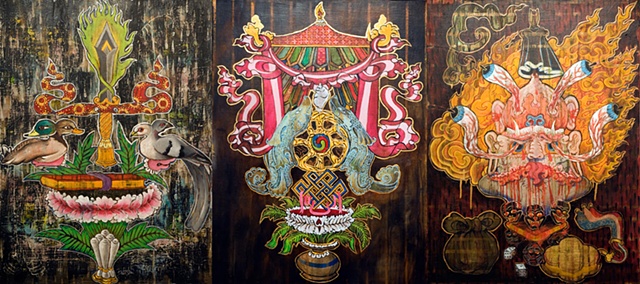SACRED IMAGES ++
OFFERINGS TO PEACEFUL DEITIES
Oil on Canvas
18” X 24”
This painting depicts the emblem of three great bodhisattvas. The lotus, book and sword. It is flanked by two double-headed birds which are an insignia of the early transmission of the Buddhist Teachings into Tibet. The birds are of western origin, ones that you may see on any given day here in North America, ducks and doves. The two beaks and eyes facing in opposite directions represent the transmission of knowledge from east to west. Both birds contain one male and one female head combining both aspects of the human species.
This image includes representations of three important Buddhist figures. The Manushri, represented by the lotus-borne book of wisdom and his flaming sword which cuts through the darkness of ignorance. The bodhisattvas Vajrapani and Avalokitesvara are represented by the ducks to the left and the peaceful doves to the right. As a trinity these images symbolize the wisdom, power and compassion. These can also be represented as the body, speech and mind of an enlightened being.
In the background are hidden the seven gems or insignia of the Chakravartin. These include, the unicorn or rhinoceros horn, interlinked square earrings, eight-branched corral, the queen’s round earrings, the cross gem insignia of the general, elephant tusks and the three eyed gems. They have been painted over in black and hide them and slightly sanded to barely reveal them.
EIGHT AUSPICIOUS SYMBOLS COMBINED
18” X 24”
These eight symbols are good luck symbols that were derived from early Indian groupings of symbols of royalty presented at ceremonies such as coronations.
These symbols of good fortune represent the offerings made by the gods to the Buddha after he attained enlightenment. Brahma was the first to appear with the offering of a thousand-spoked golden wheel requesting Shakamuni (the Buddha) to turn the teaching wheel of the dharma. Indra, the sky god then appeared, presenting a white spiraling conch as a symbol of proclamation of the dharma. The earth Goddess, Sthavara, who bore witness to the Buddha’s enlightenment presented him with a treasure vase full of the nectar of immortality.
They later became to represent the eight precious vital organs of the Buddha’s body. Parasol his spleen, the fishes his kidneys, the vase his stomach, the lotus his liver, the conch the gall bladder, the endless knot forms the intestines, the victory banner the lungs, and the wheel the heart.
A Tibetan tradition identifies the symbols are forming the body of the Buddha; The parasol for his head, the golden fishes for his eyes, the lotus his tongue, the treasure vase his neck, the wheel his feet, the victory banner his body, the conch is speech and the endless banner his mind.
OFFERINGS TO WRATHFUL DEITIES
Oil on canvas
18” X 24”
In essence, offerings presented to wrathful deities fulfill the same functions as those to peaceful ones. These sacrificial objects are offered on a purely symbolic level. To please the deity with favored offerings as a representation of the sacrifices made to show allegiance and appease the deity. You don’t offer wrathful deities flowers and sunshine you need to give them sacrifices and blood. Accompanying the offering is a sack of disease, a pair of divination dice and a death drum whose skin is pierced when the owner dies in order to release his spirit.
This is a wrathful offering of the five senses. The base of a wrathful sense offering is a skull cup mounted on a tripod of heads and contains the five sense organs. These are the heart or body representing touch and feeling; the eyes represent sight; the ears represent sound; the nose represents smell and the tongue to represent taste. They have been ripped from the body and are arranged as a ‘flower offering’. There is also the inclusion of the sixth sense faculty of consciousness, represented by a silken arrow piercing the heart. It has a black silk canopy symbolizing the subjugating and destructive power of the deity. Fresh red blood drips from the skull cup and flames emanate from around the skull. This offering would be very auspicious if made to a wrathful deity.
